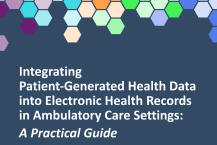National Healthcare Quality and Disparities Report
Latest available findings on quality of and access to health care
Data & Analytics
- Data Infographics
- Data Visualizations
- Data Tools
- Data Innovations
- All-Payer Claims Database
- Consumer Assessment of Healthcare Providers and Systems (CAHPS®) Program
- Healthcare Cost and Utilization Project (HCUP)
- Medical Expenditure Panel Survey (MEPS)
- National Healthcare Quality and Disparities Report Data Tools
- AHRQ Quality Indicator Tools for Data Analytics
- United States Health Information Knowledgebase (USHIK)
- Data Sources Available from AHRQ
Tools
The Agency for Healthcare Research and Quality (AHRQ) offers practical, research-based tools and other resources to help a variety of health care organizations, providers, and others make care safer in all health care settings.
AHRQ Pharmacy Health Literacy Center
This site provides pharmacists with six health literacy tools. Curricular modules that can help pharmacy faculty integrate health literacy quality improvement into courses, experiential education, and projects are also available.
Date Published: Setting of Care: Ambulatory Care, Hospital
AHRQ's Making Informed Consent an Informed Choice: Training Modules for Health Care Leaders and Professionals
These interactive training tools teach strategies that health care organizations and clinical teams can use to ensure that people understand their alternatives, including the option of not having any treatment.
Date Published: Setting of Care: Ambulatory Care, Hospital, Outpatient Surgery
AHRQ Safety Program for End-Stage Renal Disease (ESRD) Facilities Toolkit
This toolkit helps dialysis center clinicians prevent healthcare-associated infections and make care safer by following clinical best practices, creating a culture of safety, using checklists and other audit tools, and engaging with patients and their families.
Date Published: Setting of Care: Ambulatory Care, Long-term Care
Communication and Optimal Resolution (CANDOR) Toolkit
The CANDOR toolkit contains eight modules that include PowerPoint slides with facilitator notes, tools, resources, and videos, to help health care institutions and practitioners respond when unexpected events cause a patient harm.
Date Published: Setting of Care: Hospital
Community-Acquired Pneumonia Clinical Decision Support Implementation Toolkit
The Community-Acquired Pneumonia (CAP) Patient Safety Clinical Decision Support Implementation Toolkit helps clinicians and clinical informaticians in primary care and other ambulatory settings implement and adopt the community-acquired pneumonia (CAP) clinical decision support alert to identify the severity of a patient’s CAP and determine the appropriate site of care to manage it.
Date Published: Setting of Care: Ambulatory Care
Community Connections Obesity Referral Toolkit
This toolkit helps primary care practices determine and evaluate what accessible and affordable resources exist in their community for patients struggling with obesity and/or prediabetes; establish a productive relationship with community partners and develop a bidirectional referral process that integrates directly into existing patient flow; and enhance engagement strategies with patients.
Date Published: Setting of Care: Ambulatory Care
Comprehensive Unit-Based Safety Program (CUSP) Toolkit
Created for clinicians by clinicians, this toolkit includes training tools to make care safer by improving the foundation of how physicians, nurses, and other clinical team members work together and builds the capacity to address safety issues by combining clinical best practices and the science of safety. Additional AHRQ toolkits build on the CUSP model to address problems such as central line-associated bloodstream infections (CLABSI), catheter-associated urinary tract infections (CAUTI), infections associated with ventilators, surgical complications, and more.
Date Published: Setting of Care: Hospital, Outpatient Surgery
Emergency Severity Index (ESI): A Triage Tool for Emergency Department Care
The ESI is a five-level emergency department triage algorithm that helps hospital emergency department staff rapidly identify patients in need of immediate attention and better identify patients who could safely and more efficiently be seen in a fast-track or urgent care center rather than the main emergency department.
Date Published: Setting of Care: Hospital
Guide to Integrate Patient-Generated Digital Health Data into Electronic Health Records in Ambulatory Care Settings
This guide was created to support ambulatory care settings of all types in the design and implementation of successful patient-generated health data (PGHD) programs. The guide is organized into six folios that help healthcare providers and vendors navigate the many steps from design, to launch, to maintenance of a successful, sustainable PGHD program.
Date Published: Setting of Care: Ambulatory Care
Guide to Patient and Family Engagement in Hospital Quality and Safety
This guide helps hospitals work as partners with patients and families to improve quality and safety by encouraging patients and family members to participate as advisors. The tools help to promote better communication, implement nurse bedside change-of-shift reports, and engage patients and families in discharge planning throughout the hospital stay.
Date Published: Setting of Care: Hospital
















